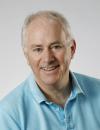Ian Chambers
Professor of Pluripotent Stem Cell Biology

- Centre for Regenerative Medicine
- Institute for Regeneration and Repair
- Head of Institute, Institute for Stem Cell Research, School of Biological Sciences
Contact details
- Tel: 0131 651 9500
- Email: i.chambers@ed.ac.uk
Address
- Street
-
Centre for Regenerative Medicine
Institute for Regeneration and Repair
The University of Edinburgh
Edinburgh BioQuarter
5 Little France Drive - City
- Edinburgh
- Post code
- EH16 4UU
Background
- 1983 - BSc (Honours, 1st Class): Biochemistry, Strathclyde, Glasgow
- 1987 - PhD: Beatson Institute for Cancer Research, Glasgow
- 1987 - 1991: Postdoc with Nobel Laureate Paul Berg, Stanford, USA
- 1991 - 2006: Senior Postdoc with Austin Smith, Edinburgh
- 2007 - 2010: Reader, Edinburgh
- 2010 - present: Professor of Pluripotent Stem Cell Biology, Edinburgh
- 2020 - present: Associate Director, Centre for Regenerative Medicine
Research summary
Embryonic stem cell biology
We study embryonic stem cells (ESCs). These cells are pluripotent, meaning they can change into all the cell types of our bodies (differentiation). ESCs can also divide to produce cells identical to themselves, a process termed self-renewal. The simultaneous possession of these properties is what makes ESCs useful.
Pluripotent cell identity is controlled by the action of transcription factors (TFs) that together form cell-specific gene regulatory networks. In ESCs the gene regulatory network is centred on the TFs OCT4, SOX2 and NANOG. We identified NANOG in a genetic screen, searching for molecules that could allow ESCs to self-renew in the absence of the otherwise obligatory cytokine, LIF. Because of this phenotype, we named it Nanog, after Tir nan Og, the mythological Celtic land of the ever-young, where visitors remain unaged. We use Nanog as a tool to investigate how pluripotent cells are regulated.
Aims and areas of interest
We study the control of pluripotent stem cell identity, focussing on three strands: (i) how transcription factors (TFs) interact with partner proteins and chromatin to direct efficient self-renewal, (ii) how changes in TF interactions drive commitment to differentiate, (iii) how the pluripotency TF network is reconfigured to enable entry to the germline.
- Simon Tomlinson
- Val Wilson
- Antonio Simeone, CNR, Naples, Italy
- Michiel Vermeulen, Rabdoud University, The Netherlands
- Satoru Takahashi, University of Tsukuba, Japan
- Laura Spagnolo, University of Glasgow
